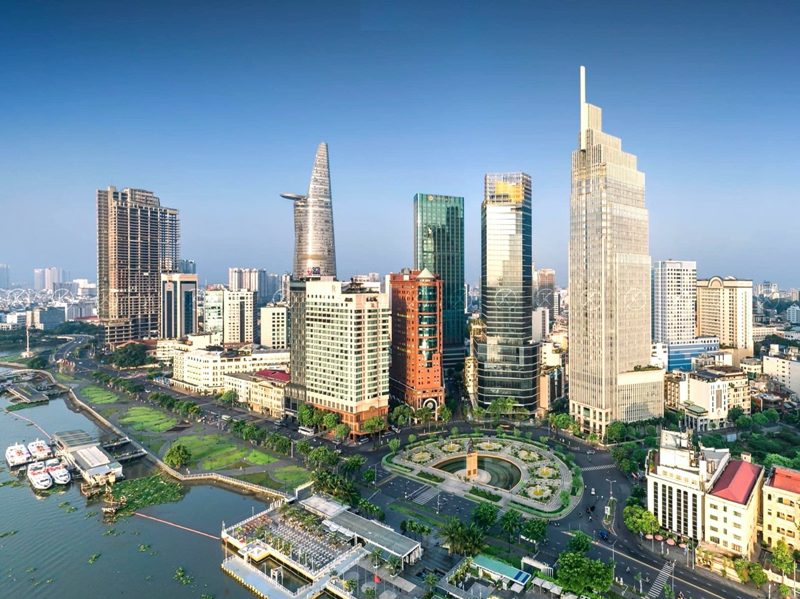Mr. Gabor Fluit, Chairman of the European Chamber of Commerce (EuroCham)

Three years into the EU-Vietnam Free Trade Agreement (EUVFTA), the impressive trade performance clearly indicates the developing relationship between our two economies as well as Vietnam’s increasing integration into the global economy.
Vietnam’s shift away from its traditional export markets toward markets in Europe is a sign of export market diversification. This is a wise move, as it stabilizes export markets against global economic problems such as currency fluctuations, trade disputes, political tensions, and changing consumer preferences.
Growth in the EU’s exports to Vietnam also signals expanded investment opportunities for European businesses, especially in non-traditional sectors beyond basic manufacturing. This expansion is indicative of a broader, more diverse investment landscape taking shape in Vietnam, with a great deal of potential for European stakeholders. High-tech manufacturing, for example, is attracting considerable interest. As Vietnam moves up the value chain from basic manufacturing to more advanced and high-tech industries, opportunities are opening up in fields such as electronics, precision engineering, pharmaceuticals, agri-tech, and green construction, to name just a few.
The rising export figures to the EU also reflect an overall increase in European confidence in the Vietnamese market. This is reflected in the EuroCham Business Confidence Index, where Vietnam now sits comfortably among the top 3 global investment destinations for 31 per cent of EuroCham members. This speaks volumes about how the European business community perceives Vietnam’s future.
The EUVFTA has driven significant growth in Europe-Vietnam trade. With its signing in 2019, the agreement has gone beyond simply cutting tariffs. Yes, over 99 per cent of goods will be exempt from tariffs by the decade’s end. However, the EUVFTA has also reduced non-tariff barriers, improved regulatory transparency, and aligned standards across our economies. This has had a real impact. Vietnam’s exports to the EU have climbed nearly 50 per cent since the EUVFTA entered into force, while EU exports to Vietnam have risen over 40 per cent. As the economic climate improves and tariffs are further reduced, these numbers will only improve.
Moreover, in response to recent shifts in global supply chains, European firms are exploring more diversified and resilient sourcing options. Vietnam, owing to its advantageous geographical location and friendly trade and investment policies, has emerged as a key manufacturing hub. This serves two purposes: it benefits Vietnam through increased investment and job creation, and it offers European businesses a more dependable alternative for their supply chain needs, improving operational stability.
Vietnam’s transition from an economy primarily focused on agriculture and basic manufacturing to one that emphasizes advanced technology and sustainable products and services is also a key driver. This shift directly corresponds with European investment priorities and consumer demand. Increasingly, European companies are investing in these growth sectors in Vietnam as part of their own global strategies, while European consumers are seeking sustainable goods and services. These trends are both likely to continue long into the future, which presents room for growth for Vietnam’s export markets.
The growth of Vietnam’s consumer market is also a key driver. As incomes increase, a growing Vietnamese middle-class is showing a strong preference for high-quality foreign goods and services. This is leading to a surge in demand for European imports, including consumer electronics, food and beverages, fashion, luxury items, automobiles, machinery, and much more.
While immediate trade gains are welcome, the EUVFTA’s true power lies in its long-term vision. It’s a robust framework, not just a temporary boost, designed to build on and reinforce EU-Vietnam trade relations for years to come. We are therefore confident that the best is yet to come for the EUVFTA.
The growing focus on sustainability and green trade practices is another element that is influencing bilateral trade. Both Europe and Vietnam are increasingly investing in sectors such as renewable energy, eco-friendly products, and sustainable agriculture. This transition towards green and sustainable trade practices mirrors a global movement towards environmental stewardship and responsibility. The alignment of EU-Vietnam trade priorities with these global sustainability trends is shaping a future where economic progress and environmental care go hand in hand. This idea was the driving force behind EuroCham’s Green Economy Forum (GEF) 2023, hosted in Hanoi last November, and it will continue to be the guiding principle for our upcoming Green Economy Forum & Exhibition (GEFE) 2024, set to take place in southern Vietnam next November.
Additionally, Vietnam is proactively developing its domestic industries, aiming to compete not just on price but also on quality. This evolution aligns well with the EU’s emphasis on quality and sustainability in trade. The transition contributes to Vietnam’s economic growth and also ensures its industries remain relevant and competitive in the rapidly-changing global marketplace. This commitment to quality, paired with competitive pricing, sets the stage for a dynamic and enduring trade relationship under the EUVFTA.
Furthermore, the evolving geopolitical landscape and shifting global economic paradigms also play a crucial role in shaping EU-Vietnam trade dynamics. In an era where global trade relations are increasingly influenced by geopolitical considerations, the strategic partnership between the EU and Vietnam serves as a stabilizing force in the region. This partnership enhances economic and political ties, and also contributes to the broader strategic balance in Southeast Asia. As the global economy continues to navigate uncertainties and shifts, and as both regions adapt to new economic realities and challenges, the EU-Vietnam relationship showcases the potential of strategic partnerships to foster economic security and prosperity.
Mr. Shantanu Chakraborty, ADB Country Director for Vietnam

2023 has been a challenging year for Vietnam’s economy. The ADB has revised its growth projection for Vietnam to 5.2 per cent for the year, down from the earlier 5.8 per cent. Strong headwinds have come from the global economic slowdown and collapsed external demand, while the government was proactive in its policy responses to maintain the recovery in 2023. Inflation is expected to have been 3.8 per cent last year, with core inflation (excluding controlled price items) at 4.3 per cent, while the consumer price index (CPI) was only at 3.2 per cent by end-November.
The key factors that kept the economy quite resilient in 2023 included the domestic recovery of services, including tourism, as well as public spending, though performance could have been better. Public investment disbursement as of the end of November reached 75 per cent of the planned expenditure in the year, a significant 22 per cent increase year-on-year. The disbursement of public investment, though still slow, partly boosted domestic consumption to 9.6 per cent in November 2023 over the same period of 2022.
FDI performance was also positive, and FDI disbursement reached $20.3 billion, up 2.5 per cent year-on-year, which is the highest increase in the first eleven months for six years. Total registered FDI as of November 25 was estimated at $29 billion, up 14.8 per cent year-on-year.
Macro-economic fundamentals remain resilient with timely monetary easing in the first half of the year, while inflation was comfortably controlled at below the 4 per cent target set by the National Assembly. The fluctuation of the VND-USD exchange rate triggered by the interest rate differential between the US Fed fund rate and the State Bank of Vietnam (SBV)’s policy rates was kept well within the latter’s 3-5 per cent benchmark range.
Key challenges are seen in the real economy, especially the impact of negative trade growth. This is compounded by a short-lived recovery around the third quarter of last year and lackluster trade performance since. As of the end of November, exports were down about 6 per cent while imports fell by over 10 per cent, resulting in an overall trade volume contraction of 8.3 per cent. While this resulted in a sizable trade surplus of almost $26 billion, it still meant that export orders, and consequently export-processing jobs, have not recovered.
Another sign of challenges was the slow credit growth, reaching only 8.21 per cent by the end of November against the target of 14.5 per cent set by the SBV. This is an indication that credit demand is growing slowly, a result of weaknesses in the real economy, including the challenges in the real estate sector.
From a broader look at the Southeast Asia region, Vietnam’s economic performance is still quite positive. The ADB has also revised its growth forecast downwards for countries in Southeast Asia to 4.3 per cent from the earlier 4.6 per cent. The revisions reflect the continued lackluster performance of manufacturing in the subregion’s more open, bigger, and trade-oriented economies such as Malaysia (with GDP forecast 4.2 per cent) and Thailand (2.5 per cent). Growth forecasts for Indonesia and the Philippines have been maintained at 5.0 per cent and 5.7 per cent, respectively, as both countries showed robust growth momentum, despite tighter financial conditions. Services and construction in Singapore continue to grow strongly, and the country’s growth forecast is unchanged at 1.0 per cent.
The ADB maintained its projection for Vietnam’s growth in 2024 at 6 per cent, assuming a certain level of recovery in the external sector, while domestic recovery could regain momentum, compared to 2023. An important driver will be prudent macro-economic stability resulting from proactive monetary and fiscal policies, continuing on from 2023. But this alone will not be enough. Public investment, domestic consumption, and export recovery will be the three main growth drivers of Vietnam’s economy in 2024.
In order, public investment as a fiscal stimulus measure should be prioritized because Vietnam still has fiscal space. Public debt was well controlled at around 38 per cent of GDP as of end-2022. Vietnam should accelerate the disbursement of sizable public investment of around $30 billion. This will directly support contracting industries such as construction and mining, and provide more employment opportunities. Policy implementation could be more effective, with efficient public investment spending in quality infrastructure to stimulate economic activities.
It is also critical to swiftly implement other fiscal measures, like the 2 per cent VAT cut, and this should be implemented until the end of 2024, not June 30. The government could also consider social safety measures to support the labor market, including unemployment allowance or reskilling incentives.
Second, domestic consumption can be boosted with increased demand from fiscal measures, supported by accommodative monetary policy to keep interest rates relatively low. Coordinated policy can effectively support economic recovery, considering relative price stability and weak demand. In the near term, monetary policy should be accommodative and fiscal policy expansionary. Slow credit growth indicates that monetary policy loosening must be closely coordinated with fiscal policy implementation to effectively boost economic activities.
Lastly, while the global market is expected to continue to face challenges over 2023-2024, it is an opportunity for Vietnam to strengthen its competitiveness and value creation in global production networks to improve its exports. This could be supplemented by stronger reforms to the business environment, the further strengthening of FDI attraction, and enhancing competitiveness to recover trade demand in 2024.
However, significant downside risks remain both externally and internally. External demand recovery is uncertain, while domestic difficulties come from the real estate sector and the significant red tape hampering domestic demand recovery.
Mr. Andrea Coppola, Lead Economist for the World Bank in Vietnam

Vietnam is considered one of the most open economies in the world. Its strong trade relations with the rest of the world are a source of strength and success. At the same time, the reliance on demand from trade partners heavily exposed Vietnam to the global economic slowdown experienced in 2023. As a result, after the very difficult Covid years of 2020 and 2021, economic performance in 2023 was the least strong since the period following the Asian financial crisis at the end of the 1990s. However, I still consider Vietnam’s economic performance in 2023 to be positive considering the very challenging global context.
The international context is expected to remain challenging this year. After the global slowdown experienced in 2023, global economic growth is expected to decelerate further in 2024, including in key trade partners of Vietnam such as the US. The expected weak performance is the result of lagged and ongoing effects of tight monetary policy, restrictive credit conditions, and weakening global trade. Downside risks predominate, including geopolitical risks, the impact of conflicts on energy prices, financial stress associated with the increase in long-term yields, and weaker than expected activity in China. In such a context, it would be important for Vietnam to reduce its vulnerability to external shocks and increasingly leverage its internal strength and domestic productivity to support economic growth.
Given that global economic growth is expected to continue slowing in 2024, I think the GDP growth target of between 6 and 6.5 per cent for 2024 is ambitious. Despite the global slowdown, demand for Vietnamese exports could gradually improve, and we project economic growth to slightly accelerate but it will be challenging to reach 6 or 6.5 per cent unless domestic demand, consumption, and investment accelerate further. Authorities can play an important role in supporting the economy though fiscal policy, particularly by accelerating the implementation of transformational public investment and infrastructure projects that are going to strengthen economic growth both in the short-term and in the longer term.
Vietnamese people are the country’s greatest source of internal strength. Vietnamese workers and entrepreneurs allowed the Vietnamese economy to grow by seven-fold during the last 30 years. To sustain this rapid growth, while also considering the challenging external environment, my suggestion is to continue promoting private sector development and boosting productivity. Vietnamese authorities can play a key role to help the country achieve this objective, and I suggest doubling efforts in human capital development, by upskilling the workforce, and physical capital development, through public investments in transport and energy infrastructure that can further strengthen the competitiveness of Vietnam’s private sector.
While we hope that demand for Vietnamese exports from the rest of the world will recover in 2024, it is not going to be as strong as in the past and this challenging situation may last for some time. In this context, my message for Vietnam is to leverage its internal strength and boost the productivity growth of its domestic economy to transform the challenges provided by the global economic slowdown in an opportunity to further strengthen its economic growth model. I would also like to take this opportunity to wish everyone a healthy, prosperous, and successful 2024.
Mr. Ken Nibayashi, Head of the Southeast Asia Desk, OECD Economics Department
Vietnam’s economy has proven remarkably resilient through the extraordinary shocks that have affected the world economy in recent years, including the Covid-19 pandemic, changing global supply chains, and the rise in global inflationary pressure. Agile policy responses have helped avoid worse outcomes, and economic growth outperformed most other Southeast Asian economies throughout the pandemic, for example. In 2023 and 2024, the economy is projected to gradually recover from domestic and external headwinds, helped by policy support and increasing external demand. Increasing government investment will also be a key driver of activity.
Despite all of Vietnam’s recent achievements, there are also challenges and opportunities for further improvement. Vietnam has a favorable business climate, but further improvements would support stronger growth, including through lower regulatory barriers in services sectors, a more level playing field between private and State-owned companies, and more high-quality infrastructure. Keeping up strong investment in human capital would help nurture high value-added sectors, alongside measures to provide more comprehensive social protection to a rapidly ageing population.
The OECD Economic Survey of Vietnam published last April projected GDP growth of 6.6 per cent for 2024. In light of more recent data releases, we would probably now have a slightly lower projection than what we had in April, but not by much. That brings our projection very close to the targets published by the National Assembly.
Taking a longer view, there are two challenges that Vietnam - and the global economy - will face: the digital transition and the green transition. These challenges will require additional policy efforts, but they also offer opportunities, notably for investment. Vietnam is already among the leaders in digitalization in Southeast Asia, but digital infrastructure should still be developed further, and enhancing the scope for competition in telecommunications may also bring new opportunities.
For the green transition towards a more sustainable and climate-friendly economy, Vietnam will require a comprehensive and predictable long-term climate strategy to guide all economic sectors towards a low-carbon path. This should include energy sector reform, which is crucial to upscale investment in renewable energies. Accelerating the establishment of a carbon market could also help to encourage investment into renewable energy sources.
Fiscal policy, and in particular public investment, will be one factor supporting growth in 2024. To maximize the fruits of this effort, it will be important to ensure that disbursements of public investment actually proceeds in line with plans. Accelerating disbursements, including by simplifying public investment procedures and regulations, would make this investment more effective.









 Google translate
Google translate